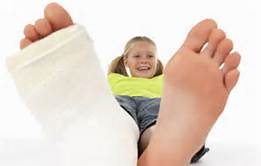 WHAT DIFFERENTIATES PEDIATRIC ORTHOPEDICS FROM ADULT ORTHOPEDICS? By: Dr. Christopher Hydorn and Jennifer Cooper, PA-C, Moore Center for Orthopedics
WHAT DIFFERENTIATES PEDIATRIC ORTHOPEDICS FROM ADULT ORTHOPEDICS? By: Dr. Christopher Hydorn and Jennifer Cooper, PA-C, Moore Center for Orthopedics
Children are NOT simply little adults.
What separates pediatric orthopedics from adult orthopedics? Adults need hip replacements and children get fractures on the playground, right? Well, there is a little more to the difference between the two in the world of orthopedics. Even with the similar injuries adult and children’s bodies often have a different response. Pediatric orthopedic surgeons are specifically trained to evaluate and treat children.
Children’s Bone Anatomy
First of all, children’s bones are substantially different than adults. Infants start off with a skeleton made of cartilage that matures into calcified bone during the early years of development. In fact, during the first few weeks of life, ultrasounds are frequently used to examine children’s bones instead of x-rays. As children grow and develop, their bones have a softer structure than adults. The softer characteristic allows their bones to fracture or break in different ways than adult bones do. The biggest difference is the presence of growth plates in children’s bones. This greatly changes the ways doctors treat and care for injuries as well as bone and joint disorders in children.
Growth Plates
Children’s growth plates are the center for bone growth. Growth plates consist of developing cartilage tissue near the end of long bones. Bones grow from the ends where the growth plates are located. Fractures can occur within and near the growth plates. These require different types of treatment compared to similar injuries in adults to avoid later problems with growth. At times the growth of a bone near a fracture can even assist in the bone healing and correcting the fracture which adds to differences in treating kids versus adults. A pediatric orthopedic surgeon is specifically trained to care for and understand these differences which results in better care and outcomes for the patients.

Children’s Injuries
Because children’s bones are different from adult bones, fractures need to be treated differently. For instance, children’s bones heal quicker than adults. This means that children need to be evaluated by a pediatric orthopedic surgeon promptly to ensure that the fracture does not need to be manipulated. If a child’s fracture heals improperly a surgery may be needed to correct it. Also, children’s fractures do not typically need to be casted as long as adults due to the faster healing potential. Not only are fractures different in pediatrics, but also in sports injuries. For example, ACL tears in pediatrics require special surgical techniques that are completely different from adult ACL surgeries.
Syndromes, Deformities, and Gait Abnormalities
Pediatric orthopedic surgeons often evaluate and treat children with special needs, deformities, and developmental delays. This includes all portions of the musculoskeletal system (bones, joints, muscles) from the neck down the spine, arms, hands, legs and feet. Since children cannot always verbalize what is wrong, pediatric orthopedic surgeons know how to examine and treat children while keeping them calm and cooperative. These can be fairly complex and often make up a large portion of a pediatric orthopedics’ practice.
Pediatric Orthopedic Surgeons
After medical school, all orthopedic surgeons complete a 5-6 year residency where they specialize into musculoskeletal treatment becoming general orthopedic surgeons. The field of orthopedics has become so large and advanced that one surgeon cannot possibly be an expert in all areas. Most orthopedic surgeons then complete an additional year or two of training in a specific smaller area within the field of orthopedics such as joint replacement, spine, sports medicine, etc. While the majority of orthopedists go into these adult areas, pediatric orthopedists get additional training in the care of kids. For pediatric orthopedic surgeons this additional year or more or training is in a children’s center where they specialize and learn details or kid’s bone and joint disorders in a much more detailed and specific level of care. At the Moore Center for Orthopedics there are currently three pediatric orthopedic surgeons who have completed this high level of pediatric training and only care for children. The Moore Center pediatric division has a pediatric specific surgeon available 24 hours a day every day to provide this advanced level of care to any child on both an emergent or elective basis.
Why go to a Pediatric Orthopedic Surgeon?
• Kid friendly environment
• Specifically trained in pediatrics
• Specialize in children’s bones and growth
• Provide pediatric specific therapy
• Utilize pediatric surgical techniques

 Tiger Buford – retained recruiter dissecting orthopedics for you
Tiger Buford – retained recruiter dissecting orthopedics for you